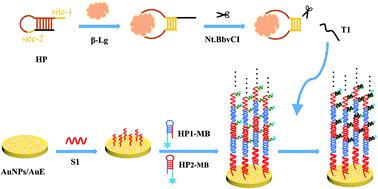Our official English website, www.x-mol.net, welcomes your feedback! (Note: you will need to create a separate account there.)
An electrochemical aptasensor for the milk allergen β-lactoglobulin detection based on a target-induced nicking site reconstruction strategy
Analyst ( IF 4.2 ) Pub Date : 2021-09-22 , DOI: 10.1039/d1an01483h Qianying Qiu 1 , Xiao Ni 1 , Tianchen Liu 2 , Zening Li 2 , Xinyi An 2 , Xiaojun Chen 1, 3
Analyst ( IF 4.2 ) Pub Date : 2021-09-22 , DOI: 10.1039/d1an01483h Qianying Qiu 1 , Xiao Ni 1 , Tianchen Liu 2 , Zening Li 2 , Xinyi An 2 , Xiaojun Chen 1, 3
Affiliation

|
Food allergy is an immune system reaction to a particular food, milk being the most common one. β-Lactoglobulin (β-Lg) is the main ingredient of milk protein and the main cause of infant milk allergy. On such an occasion, the determination of β-Lg is very important and the electrochemical sensors are a good alternative for this purpose since they are sensitive, selective and inexpensive. In this work, an electrochemical aptasensor was fabricated for the quantitative detection of β-Lg in hypoallergenic formula (HF) milk. A tri-functional hairpin (HP) was designed, which was composed of an aptamer sequence, a nicking site and a DNA sequence (T1). In the absence of β-Lg, the aptamer part hybridized with T1 to form a stable stem-loop structure. However, in the presence of β-Lg, the capture of the aptamer sequence towards β-Lg caused the reconstruction of HP and thus the nicking sites were exposed. Then, the nicking enzyme was activated and T1 could be released, which bound with the end of the hairpin 1-methylene blue (HP1-MB)/HP2-MB conjugation on the Au nanoparticle (AuNP) modified electrode surface. Thus, the insulating property of the electrode was enhanced and the current response of MB decreased, which built the quantitative basis for β-Lg detection. In this way, the proposed aptasensor exhibited a wide linear range of 0.01–100 ng mL−1 and a low detection limit of 5.7 pg mL−1. This aptasensor also displayed high selectivity, reproducibility and stability, and became a promising platform for β-Lg detection in real food samples.
中文翻译:

基于目标诱导切口位点重建策略的牛奶过敏原β-乳球蛋白检测电化学适体传感器
食物过敏是一种免疫系统对特定食物的反应,牛奶是最常见的一种。β-乳球蛋白(β-Lg)是牛奶蛋白的主要成分,也是婴儿牛奶过敏的主要原因。在这种情况下,β-Lg 的测定非常重要,电化学传感器是用于此目的的良好替代品,因为它们灵敏、选择性好且价格低廉。在这项工作中,制备了一种电化学适体传感器,用于定量检测低过敏性配方 (HF) 牛奶中的 β-Lg。设计了一个三功能发夹(HP),它由一个适体序列、一个切口位点和一个 DNA 序列(T1)组成。在没有 β-Lg 的情况下,适体部分与 T1 杂交形成稳定的茎环结构。然而,在 β-Lg 的存在下,对 β-Lg 的适体序列的捕获导致 HP 的重建,因此切口位点被暴露。然后,切口酶被激活并且可以释放 T1,其与 Au 纳米颗粒 (AuNP) 修饰的电极表面上的发夹 1-亚甲基蓝 (HP1-MB)/HP2-MB 共轭的末端结合。因此,电极的绝缘性能增强,MB的电流响应降低,为β-Lg检测奠定了定量基础。通过这种方式,所提出的适体传感器表现出 0.01–100 ng mL 的宽线性范围 电极的绝缘性能增强,MB的电流响应降低,为β-Lg检测奠定了定量基础。通过这种方式,所提出的适体传感器表现出 0.01-100 ng/mL 的宽线性范围 电极的绝缘性能增强,MB的电流响应降低,为β-Lg检测奠定了定量基础。通过这种方式,所提出的适体传感器表现出 0.01-100 ng/mL 的宽线性范围-1和 5.7 pg mL -1的低检测限。该适体传感器还显示出高选择性、重现性和稳定性,并成为用于实际食品样品中 β-Lg 检测的有前途的平台。
更新日期:2021-10-14
中文翻译:

基于目标诱导切口位点重建策略的牛奶过敏原β-乳球蛋白检测电化学适体传感器
食物过敏是一种免疫系统对特定食物的反应,牛奶是最常见的一种。β-乳球蛋白(β-Lg)是牛奶蛋白的主要成分,也是婴儿牛奶过敏的主要原因。在这种情况下,β-Lg 的测定非常重要,电化学传感器是用于此目的的良好替代品,因为它们灵敏、选择性好且价格低廉。在这项工作中,制备了一种电化学适体传感器,用于定量检测低过敏性配方 (HF) 牛奶中的 β-Lg。设计了一个三功能发夹(HP),它由一个适体序列、一个切口位点和一个 DNA 序列(T1)组成。在没有 β-Lg 的情况下,适体部分与 T1 杂交形成稳定的茎环结构。然而,在 β-Lg 的存在下,对 β-Lg 的适体序列的捕获导致 HP 的重建,因此切口位点被暴露。然后,切口酶被激活并且可以释放 T1,其与 Au 纳米颗粒 (AuNP) 修饰的电极表面上的发夹 1-亚甲基蓝 (HP1-MB)/HP2-MB 共轭的末端结合。因此,电极的绝缘性能增强,MB的电流响应降低,为β-Lg检测奠定了定量基础。通过这种方式,所提出的适体传感器表现出 0.01–100 ng mL 的宽线性范围 电极的绝缘性能增强,MB的电流响应降低,为β-Lg检测奠定了定量基础。通过这种方式,所提出的适体传感器表现出 0.01-100 ng/mL 的宽线性范围 电极的绝缘性能增强,MB的电流响应降低,为β-Lg检测奠定了定量基础。通过这种方式,所提出的适体传感器表现出 0.01-100 ng/mL 的宽线性范围-1和 5.7 pg mL -1的低检测限。该适体传感器还显示出高选择性、重现性和稳定性,并成为用于实际食品样品中 β-Lg 检测的有前途的平台。



























 京公网安备 11010802027423号
京公网安备 11010802027423号